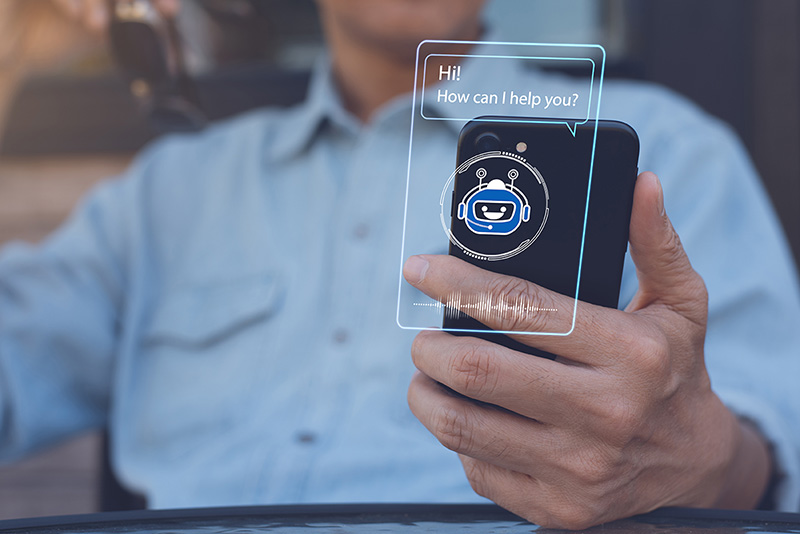Do you ever feel like your competitors have out-distanced you when it comes to using innovative technology to create exceptional customer experiences? Are there signs that your customers are lukewarm about your organization's customer support options? Maybe your agents complain about the outdated technology they use every day while assisting customers?
If you answered "yes" to any of these questions, it might be time to implement some advanced call center technologies.
There are thousands contact centers in the US. If you were to study the quality and modernity of the technology they all use, you might be surprised at how broad the spectrum is. Some operations use nearly obsolete software that doesn't even provide basic call center statistics. On the other end of the spectrum are organizations that use only advanced call center technologies that provide valuable insights about customers and have capabilities that can provide unique and satisfying customer experiences.
Most contact centers, of course, fall in between these two extremes. But given the current technical landscape, organizations should always be working their way towards the innovative side of the spectrum. This might mean incrementally replacing outdated applications with modern software or "going big" and replacing everything at once. Whatever the route and speed, contact centers should all be headed toward the same destination - an operation that leverages advanced call center technologies to satisfy and retain loyal customers.
What are advanced call center technologies?
Technology continues to advance at a rapid pace, providing contact centers with capabilities that would have been hard to imagine just a decade ago. Advanced call center technologies are infused with technology like natural language processing, machine learning, and other types of artificial intelligence (AI) to make organizations smarter and improve their ability to deliver unique, proactive, and personalized customer service.
Additionally, advanced call center technologies are typically cloud-based, which provides organizations with the agility and scalability they need to effectively react to changing business conditions, unexpected crises, and evolving consumer preferences. Being in the cloud also makes it easier for contact centers to integrate their core operational applications and service delivery channels, making the business more efficient and positioning them to deliver frictionless CX.
Advanced call center technologies also contain distinctive functionality not found in older applications. This functionality can help develop and motivate agents, improve operations, provide customers with channel choice, and more.
The contact center of the future is predictive, proactive, and hyper-focused on CX. To get there, organizations need the right technical tools.
Examples of advanced call center technologies
Bots
Bots are AI-infused technology that mimic human speech in order to interact with people in a natural, conversational manner. They can be deployed in a number of channels, including online chat, private social messaging (such as Facebook Messenger), and IVRs. Natural language processing allows bots to communicate either in writing or verbally, and machine learning helps them get smarter over time.
Bots are good for enabling self-service for simple transactions and they can answer common questions. They can also be paired with agent assistance for a more streamlined interaction. For example, a chatbot can gather customer information and hand it off to an agent for transaction completion.
Consumers and businesses both agree that bots need to get smarter, but they can still play an important role in delivering satisfying CX if deployed correctly. When we surveyed over 1000 global contact center decision makers, 46% indicated they already use bots and 32% of them said they plan to invest in bots in the coming year.
Interaction analytics
Ever wish you could get a much better understanding of what is happening during customer interactions? Interaction analytics is an advanced call center technology that allows you to do just that. This AI-infused analytics tool can sift through 100% of interactions to identify key contact drivers, identify emerging problems, determine customer sentiment and even produce transcripts of phone calls.
Contact centers have traditionally relied on ACD dispositions or informal feedback from agents and QA analysts to understand why customers are calling and if there are new problems to be addressed. This can be an inconsistent process with an unacceptably long time lag. Interaction analytics produces near real-time information that allows leaders to be proactive.
Additionally, because interaction analytics can calculate customer sentiment, it provides a much more representative view of quality and customer satisfaction, which can be drilled down to the individual customer or agent level. This allows call center managers to perform more targeted agent coaching and proactively reach out to individual customers that expressed frustration or anger during recent interactions.
Because the contact center of the future is "proactive," interaction analytics is a must-have tool.
Predictive behavioral routing
Continuing with our discussion of AI-infused tools, predictive behavioral routing takes customer-agent matching to the next level by factoring in customer personality, communication style, and experience preferences. This ensures the agent a customer is routed to not only has the skills needed to solve the problem, but also has a compatible personality to increase the likelihood of establishing rapport.
Predictive behavioral routing should be looked at as another way to personalize agent-assisted interactions. In this case, the business is matching a customer to an agent who is uniquely qualified to assist the customer based on customer attributes. It can lead to highly personalized interactions.
Video chat
Now that everyone is used to interacting via Zoom and Skype calls, it's not much of a stretch to think that the adoption of video chat will make some meaningful traction. Our CX benchmark study revealed that 26% of contact centers offer video chat support and both customers and businesses give it respectable satisfaction scores.
While video chat isn't necessary for all interactions, it can be a great way to provide product demos and training, conduct medical consultations, and assist customers who are trying to assemble or configure your products. The visual aspect of video chats also lets agents read body language and facial expressions for clues about what customers are thinking and feeling. Video conversations can also be a more effective way to make personal connections with customers.
These qualities, plus changing consumer behavior, make video chat an advanced call center technology worth considering.
Agent assistants
AI-powered automated agent assistants help agents with problem solving efforts during customer interactions. As conversations unfold, agent assistants use natural language processing to listen and interpret the issue. They can retrieve information and potential solutions from multiple systems and present them to agents. Agent assistants can also suggest next steps and perform some administrative tasks for agents.
Agent assistants are very relevant in today's contact centers. As self-service transactions increase and customers solve more of their own simple issues, the interactions that make it to agents are the more complex ones. Agents and customers benefit from tools, like agent assistants, that can help with troubleshooting these more complicated problems. Additionally, given the high levels of agent turnover that characterize contact centers, technology that can help new agents get up to speed offer a substantial benefit.
Unified agent desktops
If you expect agents to deliver outstanding CX, they need to have the right technical tools. Agents shouldn't have to toggle through four or five applications while helping customers, yet that's what far too many of them have to do. The result is a clumsy interaction that takes longer than it should. Not only is CX negatively impacted, but this scenario also creates a poor agent experience.
It doesn't have to be this way. Advanced call center technologies include unified agent desktops that consolidate the functionality agents need into a single interface. This can include:
- CRM
- All supported voice and digital channels
- Back end business systems
- Knowledge bases
- Scheduling tools
- Agent dashboards
- Quality management software
Not only is this a convenient time-saver, but a unified desktop also makes it much easier to personalize interactions by making customer information like sentiment and contact history readily available.
Gamification
Gamification can make performance improvement fun for agents by awarding them points for hitting specific milestones that can be traded in for meaningful rewards. For example, improving quality scores and schedule adherence could earn an agent enough points to get a gift card to their favorite restaurant. Gamification can be a great way to improve agent performance and motivation, which commonly leads to better CX.
Gamification functionality can be found in industry-leading performance management software and typically includes an agent interface, a leader board for group competitions, and a virtual store front where agents can cash in their points. Successful contact centers are focused on continuously improving performance, and gamification provides an effective way to inspire agents to hone their skills.
How to use advanced call center technologies to delight customers
Sometimes technical bells and whistles are just that - bells and whistles. In other words, they're cool but don't have much practical use. This isn't the case with the advanced call center technologies described above. All of these technologies have the ability to transform certain aspects of CX and contact center operations. Collectively, they position organizations to be predictive, proactive, and hyper-focused on CX.
How do they do that? Below are five examples of the types of customer experiences enabled by advanced call center technologies.
1. Innovative self-service
A Gartner study found that 70% of consumers used self-service at some point in their journey to get an issue resolved, but only 9% could fully resolve their problem using self-service channels. This tells us two things - people want to use self-service but self-service is frequently failing them.
That large gap between self-service attempts and successes represents a huge opportunity for organizations to improve CX and increase operational efficiency. Many businesses are moving beyond FAQs on their website to deliver self-service via chatbots and voice bots, which offer more assistance than traditional self-service methods. When deployed correctly, bots can provide immediate, 24/7 issue resolution to thousands of simultaneous users. And DIY customers can still solve their own problems on their own terms without needing to interact with a live agent.
2. Less friction along the customer journey
An ideal customer journey is one where the customer doesn't need to contact the business about issues the business caused such as product defects and broken website functionality. These types of problems cause frustration and erode trust. Organizations should try to significantly reduce or eliminate the need for customers to contact them about friction the business created.
Interaction analytics gives businesses the ability to stop an emerging issue in its tracks, minimizing the impact to customers. By alerting leaders about trending topics, these tools can identify customers who were impacted and help ensure other customers don’t have to deal with the same problem. Interaction analytics can help organizations be proactive, deliver better customer journeys, and remain competitive.
3. More seamless omnichannel interactions
Consumers expect omnichannel customer service in which they can start an interaction in one channel and finish in a different channel. In fact, our research indicates this expectation is nearly unanimous - 93% of consumers think businesses should provide omnichannel experiences. However, two out of three think businesses are doing a poor job of it.
Advanced call center technologies can help organizations close this gap and provide more seamless omnichannel interactions. For example, a unified agent desktop allows agents to effortlessly support all channels by providing a single interface and a consolidated inbox. The best unified desktops even let agents switch customers to different channels for a true omnichannel experience. Additionally, interaction analytics can determine customer sentiment by channel, which allows contact centers to ensure they're providing a consistent experience in all the channels they support, a critical success factor in delivering omnichannel customer service.
4. Higher first contact resolution
Just how important is it to solve a customer's issue during the first contact? A Microsoft study revealed that "33% of consumers say that the most important aspect of a good customer service experience is resolving their issue in one interaction – no matter how long it takes."
Several of the advanced call center technologies can contribute to the customer's goal of "one and done." Gamification can increase agent knowledge and skills; predictive routing matches customers with agents who are the most qualified to understand their issues and resolve them; a unified desktop ensures agents have easy access to all the systems they need; and agent assistants can guide agents through more complex issue resolution. All of these capabilities contribute to higher first contact resolution rates, which is good for both CX and the bottom line.
5. Proactive interventions and communications
Real-time interaction analytics can alert supervisors to tense interactions while they're happening. This allows them to begin monitoring the call and intervene, if needed, by "whispering" suggestions to the agent or by completely taking over the call. Additionally, if a business determines a customer is at-risk due to a rough interaction, they can quickly send a communication, such as an email with a discount offer, to try to salvage the relationship.
The same Microsoft study cited previously revealed "70% of global consumers have a favorable view of brands that contact them with proactive customer service notifications." Proactive interventions and communications will become increasingly important as businesses fight to keep every customer.
Advanced call center technologies in action

Expivia
Expivia is a US-based BPO that provides contact center services for its clients. The company has wholeheartedly embraced interaction analytics to add value to its internal operations as well as its clients. For example, Expivia provides incentives to its agents based on customer sentiment scores. Additionally, it uses the information provided by the analytics tool to give its clients more insight into call drivers and customer satisfaction. For instance, Expivia discerned that one of its clients had a fulfillment issue that was generating calls and frustrating customers. Once the client fixed the problem, things improved significantly.
If you're interested in learning more, watch this on-demand webinar: Transform with CXone Interaction Analytics.
DSW
DSW is a well-known retailer that sells shoes and clothing accessories. As the company experienced rapid growth, their customer service operation also experienced unsustainable expansion. Looking for a solution that would improve efficiency and CX, they decided to implement a voice bot in their IVR. The initial deployment focused on authenticating callers in the IVR before transferring them to agents, a great example of a blended bot/live agent interaction. The next iteration focused on automating two self-service transactions - password resets and checking order status. Since implementing the voice bot, customer satisfaction has increased by 30% and average handle time has decreased by two minutes.
Watch our on-demand webinar, CXone Powers DSW’s Transformational Journey to AI-Powered Virtual Agents, for more information about this powerful use of advanced call center technologies.
Summary
Advanced call center technologies will take customer service operations into the future and ensure businesses are prepared to meet consumers' ever-increasing demands. Modern contact centers leverage innovative technology to provide exceptional CX, motivate agents to improve performance, and increase operational efficiency. Advanced technology allows contact centers to be predictive, proactive, and hyper-focused on CX. Do you have a plan for moving your contact center closer to the innovative side of the technology spectrum?
New to NICE?
NICE CXone, the world’s #1 cloud customer experience platform, transforms your call center software – empowering exceptional agent and customer experiences: every channel, every time. CXone leverages advanced call center technologies to enhance customer experiences and streamline operations.
To find out more, visit our product page or watch a demo.






